The Windows 10 Review: The Old & New Face of Windows
by Brett Howse on August 25, 2015 8:00 AM EST- Posted in
- Operating Systems
- Microsoft
- Windows 10
Performance: Windows 10 Follows in the Footsteps of Windows 8
There have been a lot of changes to Windows performance over the years when a new version comes out. It was pretty much a given than any new version would require more hardware than its predecessor. Things started to change with Windows 7, which had basically the same hardware requirements as Vista. Windows 8 took that even further, by having the same requirements initially, but working on making things like boot time much quicker. Windows 8.1 update actually lowered the hardware requirements over Windows 8 with things like WIMBoot.
Windows 10 does not have any major changes to the underlying platform this time. Yes, there are some new things like DirectX 12, and WDDM 2.0, but overall it has been a pretty stable set of requirements. In fact, the base system requirements are exactly the same as Windows 8:
- 1 GHz Processor
- 1 GB RAM (32-bit) or 2 GB RAM (64-bit)
- 16 GB Storage (32-bit) or 20 GB Storage (64-bit)
- DirectX 9 capable graphics with WDDM 1.0 driver
- 800x600 display resolution
Now, granted, these are minimums, but the system will run on that. Even low cost tablets are going to have slightly more than these minimums so Windows 10 should be no issue for even older machines.
On that note, one new feature not currently available on Windows 10 but will be rolling out in a future update is memory compression, which is an evolution of the memory deduplication added in Windows 8. With memory compression, when the memory subsystem is pressured by too many active pages, the system will compress some of the pages rather than page them to disk. The CPU power required to compress and decompress the pages will of course be increased, but the overall system speed should feel a lot snappier than when having to recovery pages from disk. This will be of most benefit to the lower cost devices such as tablets which come with the minimum memory specificatioins.
But, despite the lack of differences in minimum requirements, it could still be the case that Windows 10 is going to use more or less of the hardware that is available. Is it going to offer more performance than Windows 8, or less? Let’s take a look.
Boot Time
One area where a lot of effort was spent in the Windows 8 days was boot time. There were some pretty dramatic improvements made here over Windows 7, and the proliferation of UEFI in new systems has helped to speed this up the point where we now measure boot time in seconds rather than minutes.
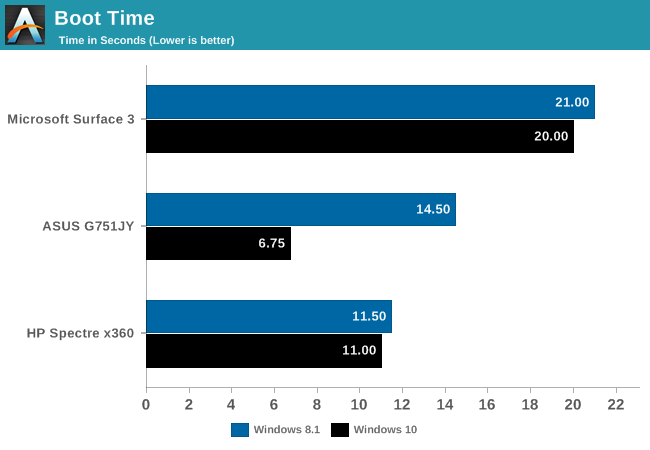
Overall, the system boot time is not significantly different in Windows 10. For most devices, it was within a second either way. The ASUS G751 that I tested may be an outlier here, but on this one device I did see a big gain. There could have been software loading at launch which was removed as part of the upgrade, but regardless, Windows 10 boots at least as fast as Windows 8, and sometimes even faster.
Power Consumption
Another area where it is important to measure is power consumption. Windows 8 made some good gains here over Windows 7, and while this was not the focus of Windows 10, it will be important not to lose ground here either.
To test this, Ganesh ran his standard idle and load test on the Intel NUC with the Core i5-5250 processor. Load is running Prime95 and Furmark at the same time, which is really going to show the maximum power consumption of the platform.
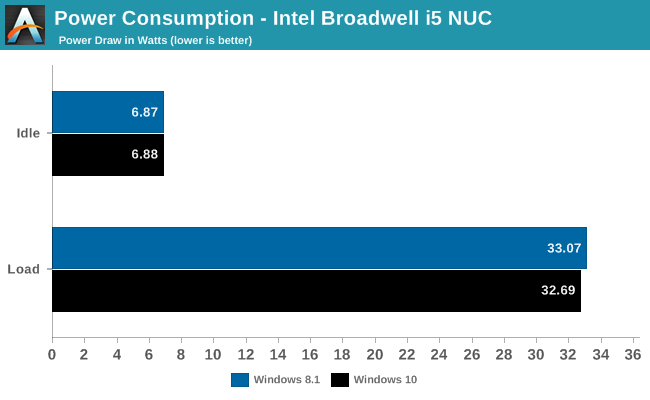
As we can see here, both levels are practically identical, which in this case is not a bad thing. There were no promises of better power usage, but ensuring there was not a regression is important.
Battery Life
Another test which I felt was going to be quite relevant is tablet battery life. I upgraded the Surface 3 to Windows 10, and ran through our tablet Wi-Fi battery life test with the display at 200 nits.
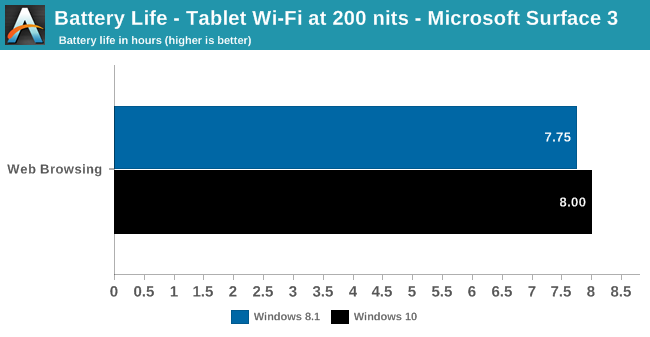
Here we see a slight improvement in overall battery life. I got 16 minutes more time on Windows 10 than I did on Windows 8.1. There is always a bit of a variance in this test, but once again not having a regression is a positive. Although impossible to directly measure, using Edge as the browser over Internet Explorer 11 could also provide some of this time gained since the new browser performs so much better, it can race to sleep quicker after loading the page.
One test that will have to wait is the tablet video test. I’ve run it, but I need to test a few other devices before I am ready to give out the results.
System Performance
As far as system performance, I also ran the Surface 3 through the PCMark 8 suite which simulates real life workloads.
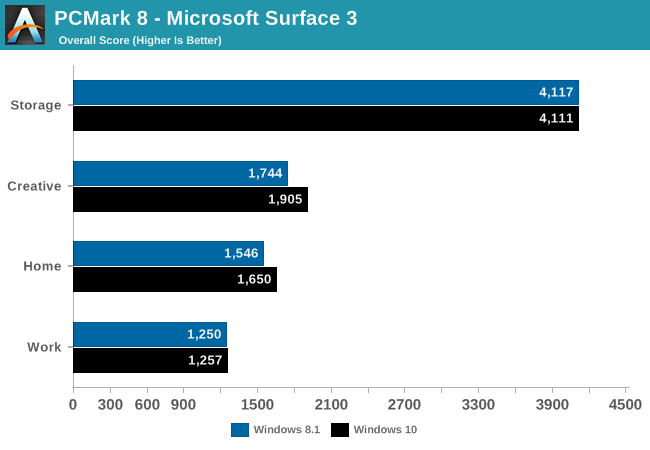
Looking at PCMark is interesting since the benchmark is really a comprehensive look at the entire system. As you can see, both the Creative and Home scores have jumped up. The workloads in both of these include gaming, and the Work test does not, so it is possible this is due to new Windows 10 graphics drivers. Other media capabilities are also tested whereas the Work test does not include media at all.
I also ran some tests on a much more powerful system to see how it performed. The ASUS G751 laptop is a gaming laptop with a quad-core Haswell mobile i7, 24 GB of memory, and a NVIDIA GTX 980M GPU.
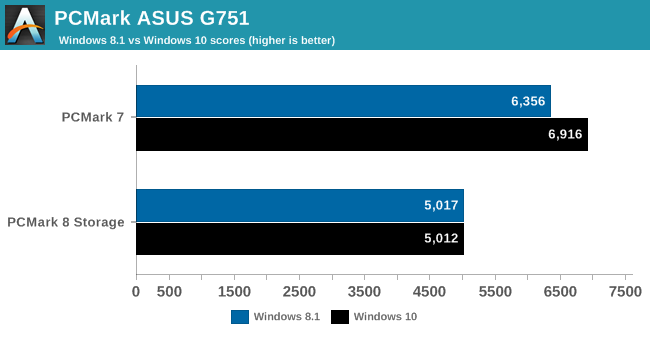
Again on PCMark we see a substantial gain, as we did on the Surface, even though this is PCMark 7 compared to PCMark 8 on the Surface 3. The ASUS G751 would crash the PCMark 8 workloads in Windows 10. This is a substantial gain though. Windows 10 does have some memory management improvements but it is difficult to believe this would affect a system like this with 24 GB of system memory. Updated graphics drivers for Windows 10 may explain the gain here.

Cinebench is a purely CPU benchmark, and Windows 10 shows the exact same scores for this benchmark. There is no loss of performance though which is really the main concern.
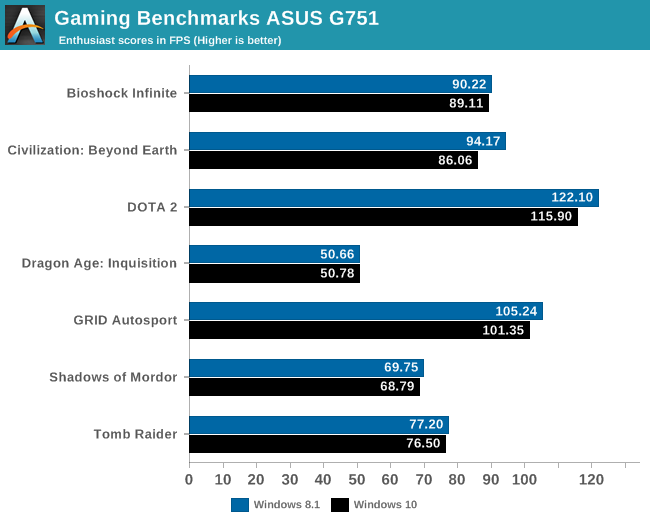
Overall the gaming results are very similar from Windows 8.1 to Windows 10, but unlike PCMark, there is a slight decrease in overall frames per second. Some of the games are very close and within the margin of error, but DOTA 2 saw a 5% decrease in performance which is significant. Civilization: Beyond Earth dropped 8% from moving to Windows 10. Unfortunately the laptop does not have integrated graphics or an AMD card to see if this is consistent across other cards or just a driver issue with the new NVIDIA drivers for Windows 10.
Desktop Gaming Performance
Shifting gears, let’s take a wider look at gaming performance on our GPU testbed. To better quantify the performance impact of Windows 10 we’ve gone ahead and tested a selection of games across GPUs from all of the major discrete GPU generations from both AMD and NVIDIA. This means Radeon R9 Fury, R9 290X, and R7 370 for GCN 1.2, GCN 1.1, and GCN 1.0 respectively. And for NVIDIA, GeForce GTX 980 Ti, GTX 750 Ti, and GTX 680 for Maxwell 2, Maxwell 1, and Kepler, in that order.


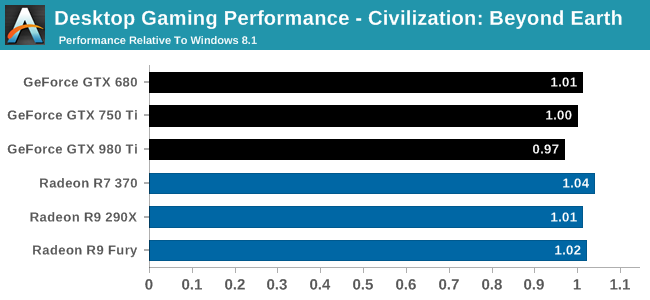
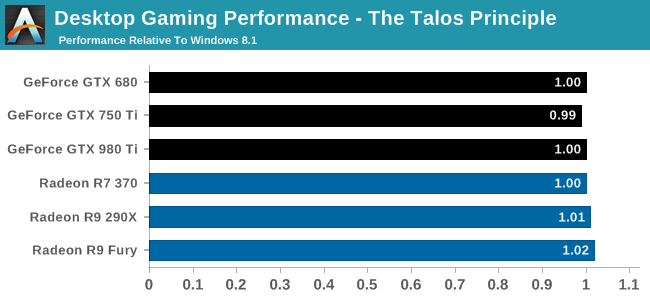
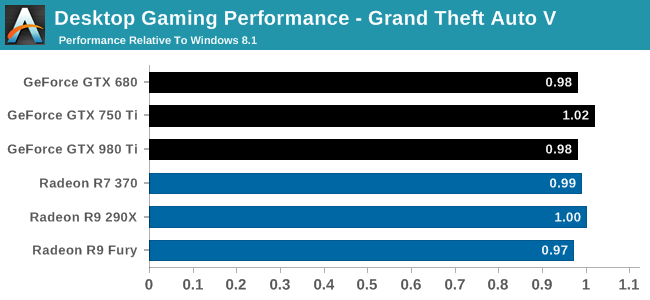
Despite being the biggest graphics stack overhaul since Vista, gaming performance is remarkably consistent on our GPU testbed, even more than on our laptop testbed. Performance is on average unchanged, and the results we see are typically within the +/- 3% variability we see when benchmarking GPUs. No game and no vendor sees an improvement from Windows 10.
This if anything is a testament to the work put in by Microsoft and the GPU vendors ahead of Windows 10’s launch. Though admittedly not starting from scratch, all of the relevant parties have been able to get their driver performance up to expectations by launch, avoiding the teething issues of Vista. Though we suspect the DirectX 12 code paths will still be under major development for some time to come, at this point it’s safe to say that upgrading to Windows 10 will not have a detrimental effect on current DirectX 11 games.
In Summary
So does Windows 10 perform better or worse than Windows 8.1? Overall I would say it is more or less similar, with some improvements in some tests and at worst a slight decrease in some of the laptop (and only laptop) gaming scores. There is not a major performance regression seen, at least on the devices that were tested so far. Windows 8 made some big performance gains over Windows 7 in several areas, and Windows 10 appears to continue to slightly refine things again. Despite the re-additon of things like transparency the battery life was slightly better when browsing the web, which is a good sign considering the new web browser being used.
Windows 10 does not really lose any ground to the gains that Windows 8 made, and as a result it's in good standing right out of the gate.










293 Comments
View All Comments
inighthawki - Tuesday, August 25, 2015 - link
Lol this image is so full of crap. Not only can you turn most of it off permanently (And yes, you can disable WU and WD from the services list and it will not start back up) but this image is so misleading. They even photoshopped an ad in the start menu on a setting that doesn't even exist in the RTM build... Come on, that's low. Mos tof the other things such as "tracking keystrokes and browsing history" for wbe browsing exist in Windows 7 and 8. Wi-Fi sense has been known to be blown way out of proportion. Telemtry has also been proven to only provide non-personal information. It collects stuff such as hardware configurations, statistical information like how often you click the start button, and machine crashes. Does this seriously worry you that Microsoft knows that "someone in the world" owns a MacBook pro and clicked the start button 8 times today?You're really just buying into a bunch of fearmongering by a bunch of people who just wanted excuses to continue using Windows 7. If you don't like Windows 10 or don't want to use it, that's fine, but don't cite these ultra poor excuses as the reasons why, as it shows you didn't actually look much further than the surface, and just jumped on the bandwagon.
Notmyusualid - Tuesday, August 25, 2015 - link
Thank you for your (what I believe is an incorrect opinion), but I HAVE EVERYTHING TURNED OFF, and my firewall logs STILL show encrypted packets going out to Microsoft - EVERYTIME I hit a key, and everytime I open a program.So even if somebody starts with a Microsoft Account, their data would be synced to MS, before many would realise what had happened.
There is absoultely nothing you can say that would make me believe that MS deserves access to my contacts. Those are private.
And no, I did not jump on any bandwagon, I did my own testing, came to similar conslusion as the picture stated, and yes, I will be continuing to use Win 7, as I do not like it.
Only Enterprise Editions can disable all modes of telemetry...
inighthawki - Tuesday, August 25, 2015 - link
Oh OK, so you saw encrypted packets going out... So I guess you decrypted them and looked at the content, then? Sending information when certain types of hardware interrupts occur does not mean they are sending personal information or recording your keystrokes like a keylogger. You have no way of knowing what's in the packets, yet you make assumptions that it's a privacy issue. Yet another example of someone pretending they're fully informed because they open up Wireshark and see some packets being sent over the network and "came to a conclusion" about what was really happening.minijedimaster - Tuesday, August 25, 2015 - link
Are you paid to have some shill answer for everything windows 10? "Oh well, so you proved me wrong with your firewall packet captures, but do you REALLY know what it's sending???"LOL, yeah ok... go be a paid shill somewhere else.
inighthawki - Tuesday, August 25, 2015 - link
Sorry if I'm not irrational/paranoid and don't jump to conclusions based on evidence that doesn't actually show any of the claims you're making.Oh no, a network packet! My entire life must now belong to Microsoft's hands!
SlyNine - Tuesday, August 25, 2015 - link
I have to disagree. Your computer sending encrypted packets to Microsoft, even tho you supposedly disabled that stuff, is a HUGE red flag. At that point its up to Microsoft to convince me that they are NOT sending personal information (it shouldn't be sending any). I might have to pass on windows 10 until this gets clarification.imaheadcase - Wednesday, August 26, 2015 - link
Most modern windows OS send data to MS encrypted, almost all programs with internet connectivity do. The OP is prob just looking at the encrypted data it sends to check for windows updates. Has nothing to do with privacy.Holy hell did everyone just step on the jump to conclusions mat. lol
Notmyusualid - Friday, August 28, 2015 - link
It has everything to do with privacy.Every time I press a key, a packet is sent. This is not updates.
Notmyusualid - Friday, August 28, 2015 - link
It IS a Huge Red Flag.This guy is a Microsoft employee.
nikon133 - Sunday, August 30, 2015 - link
You sound like you might be working for competition, though. Apple? Some shady Linux brotherhood? Just saying.